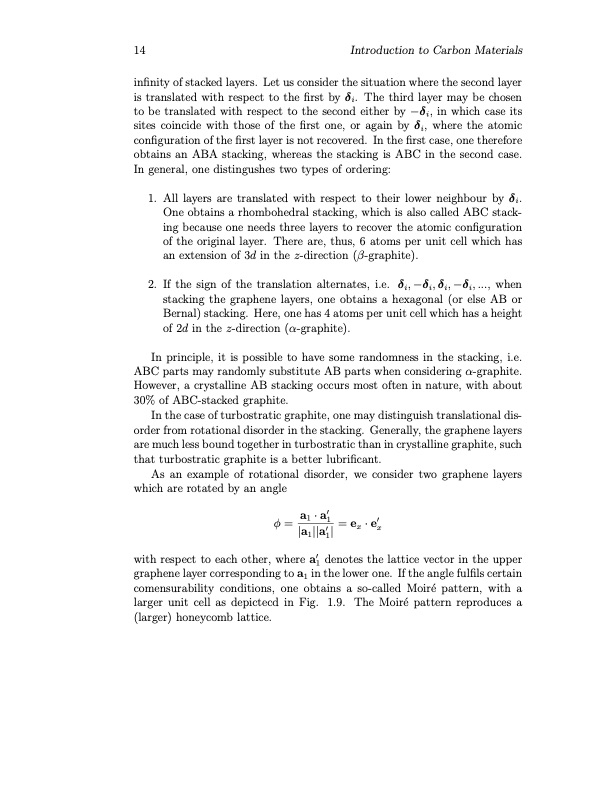
PDF Publication Title:
Text from PDF Page: 018
14 Introduction to Carbon Materials infinity of stacked layers. Let us consider the situation where the second layer is translated with respect to the first by δi. The third layer may be chosen to be translated with respect to the second either by −δi, in which case its sites coincide with those of the first one, or again by δi, where the atomic configuration of the first layer is not recovered. In the first case, one therefore obtains an ABA stacking, whereas the stacking is ABC in the second case. In general, one distingushes two types of ordering: 1. All layers are translated with respect to their lower neighbour by δi. One obtains a rhombohedral stacking, which is also called ABC stack- ing because one needs three layers to recover the atomic configuration of the original layer. There are, thus, 6 atoms per unit cell which has an extension of 3d in the z-direction (β-graphite). 2. If the sign of the translation alternates, i.e. δi,−δi,δi,−δi,..., when stacking the graphene layers, one obtains a hexagonal (or else AB or Bernal) stacking. Here, one has 4 atoms per unit cell which has a height of 2d in the z-direction (α-graphite). In principle, it is possible to have some randomness in the stacking, i.e. ABC parts may randomly substitute AB parts when considering α-graphite. However, a crystalline AB stacking occurs most often in nature, with about 30% of ABC-stacked graphite. In the case of turbostratic graphite, one may distinguish translational dis- order from rotational disorder in the stacking. Generally, the graphene layers are much less bound together in turbostratic than in crystalline graphite, such that turbostratic graphite is a better lubrificant. As an example of rotational disorder, we consider two graphene layers which are rotated by an angle φ=a1·a′1 =ex·e′x | a 1 | | a ′1 | with respect to each other, where a′1 denotes the lattice vector in the upper graphene layer corresponding to a1 in the lower one. If the angle fulfils certain comensurability conditions, one obtains a so-called Moir ́e pattern, with a larger unit cell as depictecd in Fig. 1.9. The Moir ́e pattern reproduces a (larger) honeycomb lattice.PDF Image | Physical Properties of Graphene

PDF Search Title:
Physical Properties of GrapheneOriginal File Name Searched:
CoursGraphene2008.pdfDIY PDF Search: Google It | Yahoo | Bing
Salgenx Redox Flow Battery Technology: Power up your energy storage game with Salgenx Salt Water Battery. With its advanced technology, the flow battery provides reliable, scalable, and sustainable energy storage for utility-scale projects. Upgrade to a Salgenx flow battery today and take control of your energy future.
| CONTACT TEL: 608-238-6001 Email: greg@infinityturbine.com | RSS | AMP |